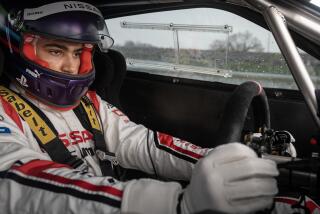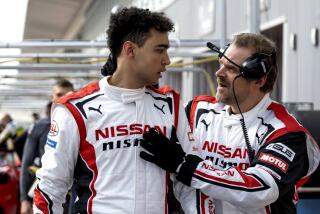‘Gran Turismo’ a Driving Force
- Share via
Since hitting store shelves in 1998, “Gran Turismo” has become practically synonymous with the PlayStation console. Some would argue that the “Gran Turismo” franchise, which has sold 15 million copies worldwide--helped cement PlayStation’s position as the No. 1 console.
On July 10, eight months after the U.S. launch of PlayStation 2, Sony Computer Entertainment of America released “Gran Turismo 3: A-Spec.” Touted as the “killer app” for the PS2, “GT3” was created using the same physics engine used to generate the first two GT games.
So what makes it better? Much of it is in the details. Thanks to the more powerful PS2 hardware, the creators of “GT3” were able to pack a lot more data into the game. For example, each car has in excess of 4,000 polygons, or individual shapes used to render the vehicle, as opposed to about 200 polygons in previous versions.
The producer of the three “Gran Turismo” games, Kazunori Yamauchi, 33, talked about his latest creation from Japan.
Q: So how does one go about making a killer driving game?
Set high goals. Make no compromises. Be lucky. Seriously, though, don’t think how a car would behave. Think about how a car is built. Go back to the basics. Concentrate on re-creating a real-life car. Don’t concentrate on how the car moves. With a lot of designers, the first impulse is to make it do power slides or go at ridiculously fast speeds. They start by making the cars move. Our team doesn’t care about that. They care about how the cars are built. The slides and high speeds, that happens on its own. Think about building the car first. That means paying attention to the game engine.
Q: What lengths did you go to to make the game realistic?
There are two parts to this. We had to first get access to all 150-plus cars in the game. We rented some from the manufacturers. Sometimes we had to go to car owners clubs. We took hundreds of photos for each car. These became reference points for us to model them into the game. The staff also had to take the cars for a spin to experience what each car is like. We then recorded engine sounds for each car, which also gets incorporated into the game.
The second part involves implementing all the data we obtain about each car. That’s the toughest part. For each car, there are 200 to 300 parameters, from the horsepower to the gear ratios. That’s where our physics engine comes in. We spent four years developing it. It’s the heart of this game. When you change the suspension by just 1 millimeter, it calculates how that affects the angle between the tire and the road. That in turn affects the way the car handles and the visual representation of the car in the game, all of which is done instantaneously.
Q: Do the car manufacturers pay Sony to be in the game? Or does Sony have to pay them licensing fees?
It would be nice for them to pay us. But the truth is that there would be a lot of limitations on how we design the game if the manufacturers were to pay us. It’s better if we pay them for the license, because then we can do what we want. This allows us greater latitude.
Q: Did you have to tweak the game at all to make the driving different from how it would be in real life?
In the previous versions of the game, we had to do more of that, just to make the game enjoyable. We had to up the tire traction significantly so players could race without sliding all over the road. But with PS2, the cars drive more true to life. You can plug all the real parameters into the physics engine, and it actually drives well immediately. It boils down to how the game’s engine calculates the physics. Before, you couldn’t tell the difference when the suspension bounced between 1 millimeter or 10. Now you can.
Q: What was the hardest thing about making this game?
A: Overall, the hardest thing was making the engine. At first, our cars would not behave like cars. They would fly or start digging in the ground or float like Hovercrafts. Just making the cars behave like cars was the most difficult part.
Q: Did you personally drive each of the cars in the game?
A: Of the over 150 cars, I’ve driven 130.
Q: What’s your favorite car in “GT3?”
I would have to say it’s the Japanese cars: the Mitsubishi Lancer Evolution, the Honda S2000 and the Mazda RX-7.
This interview was translated by Taku Imasaki, the U.S. producer of “GT3.”
*
Times staff writer Alex Pham covers the video game industry.
More to Read
The biggest entertainment stories
Get our big stories about Hollywood, film, television, music, arts, culture and more right in your inbox as soon as they publish.
You may occasionally receive promotional content from the Los Angeles Times.










